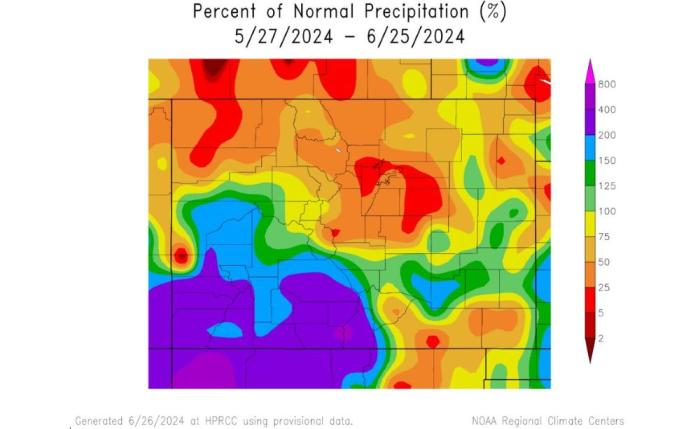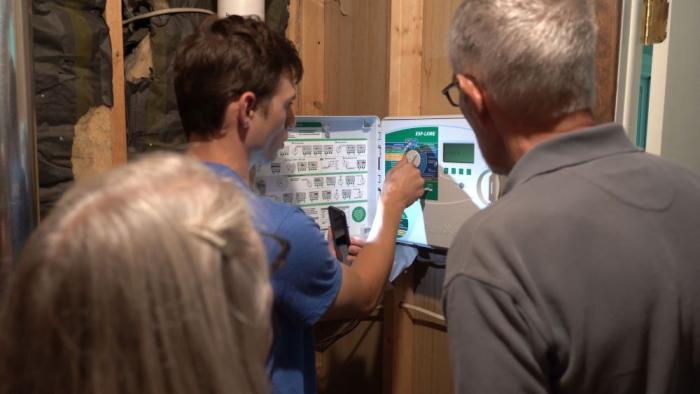You water your yard when?!?
During a very hot and dry June — the second hottest on record for the Denver area — Denver Water customers continued to do a solid job managing their irrigation needs.
Even with the seemingly endless string of days with temperatures in the 90-plus range, overall water use — while high — was nowhere near record-setting. People have changed their watering habits and their landscapes, and those changes are sticking, even in this year’s broiling June that ended Sunday.
But we’re not done yet! (And we have a favor to ask.)
Customers and landscapers continue to favor a common setting on their irrigation settings: 5 a.m. on Mondays. It seems to be either a default setting — or perhaps a natural inclination for those looking to follow the no more than three days per week summer watering rule. Make the first day Monday and go from there.
But there’s a downside to following the Monday-morning-at-5 herd.
Denver Water’s system takes a beating every Monday at 5 a.m., as millions of gallons of water thunder through pump stations and mains to satisfy the enormous demand tied to irrigations systems programmed to turn on during that time slot.
“That big jump in demand for water creates more wear and tear on the system,” explained Greg Fisher, who oversees water demand for the utility. He compares it to a car you drive too hard.
“All those hard starts and stops take their toll.”
And water demand on a recent Monday morning soared to levels not seen in years.
On Monday, June 24, in the 5 a.m. hour, Denver Water saw water use hit a “Maximum Hour” that, if it had kept up for 24 hours, would have translated into a daily rate of 685 million gallons. That is the highest “Max Hour” in almost 20 years, since 2005 when the figure hit 709.
(In the water industry, the “Maximum Hour” is the hour in which the maximum volume of water is delivered to a system. It’s expressed in gallons per day and used to determine how to size the system.)
It’s important to note the June 24 “Max Hour” demand for water didn’t translate into higher overall water use. In fact, over the course of 24 hours on that day, June 24, Denver Water’s customers used 346 million gallons of water.
Catch up on ColoradoScaping, at denverwater.org/Conserve.
That’s high, but not remarkably so for a smoldering June day.
Again, customers’ good habits are leading to lower demands overall, even during the very hot summers we’ve seen several times since 2000.
Denver Water wants to work with customers to “shave the peak.”
The utility is asking customers to ease the strain on the water delivery system by spreading out their use. That way, fewer people are seeking water at the same time.
It’s not unlike what electric utilities are doing when they ask their customers to pull a bit less power from the system on hot summer afternoons when everyone is maxing out their air conditioners.
At Denver Water, the “Max Hour” is one of the only areas where the utility is seeing water use trends going the wrong way.
“Until recently, customers’ annual use, maximum daily use and maximum hour use were all dropping,” explained Ryan Shepler, a senior planner in Denver Water’s demand planning group. “But now, compared to the other two areas, the maximum hour use is no longer declining in the same way — and it might be increasing.”
That puts stress on the system.
The utility must size its system to handle those punishing maximum hour loads. That translates to more cost, as pipes, pumps and myriad other equipment must be built to meet the peak loads of water demand.
So, how can customers help? By doing something that’s pretty easy.
Simply consider switching the timing on your irrigation controller.
Love the Monday morning watering time? Fine. Simply switch to 3 a.m. or 4 a.m. instead.
Or, set the system for Sunday or Tuesday instead. And remember, outside of the very hottest stretches, a lot of landscapes, even lawns, can do fine with just twice-a-week watering.
And remember, too, you can choose a landscape that can endure through months like this year’s June, when long strings of 95+ degree days otherwise take their toll.
Denver Water is encouraging customers to consider “ColoradoScapes” for some or all their yard.
These are landscapes that emphasize prairie grasses and native plants built to withstand the sometimes-tough summer climates of the Rocky Mountain West. We’ve written quite a few stories about them on TAP: look for the Plant Select label, six myths about water-wise plants and ditch useless turf.
Best of all, with a ColoradoScape, your irrigation system can take a break. It can even sleep in on a Monday morning.
No need to wake it up at all, much less at 5 a.m.





